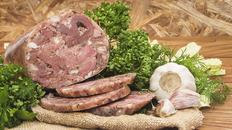Meats and Sausages
City Head Cheese
Head cheese also known as brawn or souse is a jellied meat sausage that is stuffed in a large diameter casing or it may be placed in a form becoming a jellied meat loaf. Traditionally made head cheese employed meats that were rich in collagen which was required to produce a natural gelatin (broth) that after cooling became a jelly. The best meat was highly flavored pork head meat and pork legs and feet (hocks). A person living in a large city may not be able to find these cuts anymore but intelligent substitutions can easily be made by buying commonly available supermarket carried meats and the final product will be of very high quality yet much easier to make. The easiest way to make a head cheese is to think in terms of cooking a heavy meat broth which may or may not be stuffed into casings.
| Meats | Metric | US |
|---|---|---|
| pork picnic, hocks | 1000 g | 2.20 lb. |
Ingredients per 1000g (1 kg) of meat
| salt | 18 g | 3 tsp. |
| white pepper | 2.0 g | 1 tsp. |
| garlic | 3.5 g | 1 clove |
Instructions
- Making Broth:1/2 pork picnic (front leg) or pork butt. The amount of boiled meat available for further processing will be about 2.2 lbs. (1 kg). Picnic meat is fattier with more connective tissues (collagen) and will produce more gelatin than a butt. The butt has only one little bone and its meat is leaner than a picnic and a commercial gelatin (natural product made from bones and skins) will have to be added.
- Two pig feet (hocks). If you use hocks and picnic enough natural gelatin (broth) should be produced to create jelly on cooling. If pork butt is the only meat used you will have to mix your own gelatin.
- 3 bay leaves, 1 stalk celery, 1 carrots, alt and pepper to taste, 1 package of gelatin (if needed).
- Place meats and other ingredients in a pot and cover with about two inches of water. Cook below boiling point for about 3 hours or until meat separates easily from bones. Strain liquid and save for later.
- Separate meats from bones. It is easier to perform this task when meats are still warm. Cut meats into smaller pieces. It is easier to cut them when they are chilled. Normally the leaner the meat the larger diameter the cut. Fatter meats and fat will be chopped into smaller pieces.
- Dissolve gelatin in 1/4 cup room temperature water and stir in into your hot meat broth.
- Mix meats with meat broth/gelatin and add garlic and salt and pepper to taste. Head cheese does not require much salt and a low sodium product can be made.
- Now you can go two different ways: make a meat jelly by pouring your head cheese into containers, let them sit for 2 hours at room temperature and then place in a refrigerator. Keep it there for 12 hours to give the head cheese time to set OR
- Stuff with a ladle into large diameter waterproof casings, clip the ends and cook (simmer) in hot water at about, 185º F (85º C). A rough estimate will be about 20 min for each ½” (12 mm) of diameter of a casing. Or using a thermometer cook to 160° F (72° C) internal meat temperature. Then place at room temperature for about 2 hours for gelatin to set. Place for 12 hours in a refrigerator.
Notes
It is easy to add a degree of sophistication to your product by decorating your gelatin when using containers as head cheese is normally removed from containers and turned upside down when served. This way any decoration will rest on top of the product. Of course, any decoration such as sliced hard boiled egg, sliced lemon or pickle, must be placed on the bottom of container first, then covered with mixed with water gelatin powder and allowed to set. Then add shredded/cut meats and pour hot stock over.
Head cheese is eaten cold with bread and some vinegar or lemon juice is sprinkled on top of it.
Head cheese that is stuffed in casings is sliced and eaten like any other regular sausage.


















